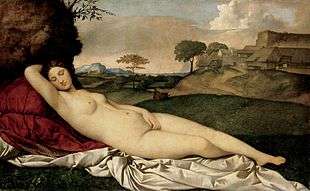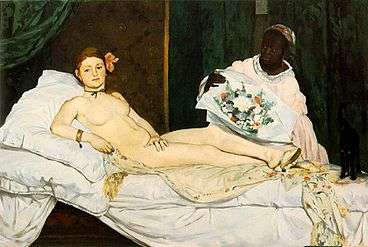Sleeping Venus (Giorgione)
 | |
| Artist | Giorgione, Titian |
|---|---|
| Year | c. 1510 |
| Medium | Oil on canvas |
| Dimensions | 108.5 cm × 175 cm (42.7 in × 69 in) |
| Location | Gemäldegalerie Alte Meister, Dresden |
The Sleeping Venus, also known as the Dresden Venus, is a painting by the Italian Renaissance master Giorgione. It was completed after Giorgione's death in 1510, with the landscape and sky generally accepted to have been completed by Titian.[1] It is in the Gemäldegalerie, Dresden.
The painting, one of the last works by Giorgione, portrays a nude woman whose profile seems to follow that of the hills in the background. Giorgione put a great deal of effort into painting the background details and shadows. The choice of a nude woman marked a revolution in art, and is considered by some authorities one of the starting points of modern art. The painting was unfinished at the time of his death. The landscape and sky were later finished by Titian, who later painted the similar Venus of Urbino.
Underlying erotic implications are made by Venus's raised arm and the placement of her left hand on her groin. The sheets are painted in silver, being a cold colour rather than the more commonly used warm tones for linens, and they are rigid looking in comparison to those depicted in similar paintings by Titian or Velázquez. The landscape mimics the curves of the woman's body and this, in turn, relates the human body back to being a natural, organic object.
In his monograph of Renaissance art, Sydney Freedberg writes:
The shape of being is the visual demonstration of a state of being in which idealized existence is suspended in immutable slow-breathing harmony. All the sensuality has been distilled off from this sensuous presence, and all incitement; Venus denotes not the act of love but the recollection of it. The perfect embodiment of Giorgione's dream, she dreams his dream herself.[2]
The pose of the figure has been connected with a figure in one of the woodcut illustrations to Hypnerotomachia Poliphili of 1499,[3] but a nude of this size, as a single subject, was unprecedented in Western painting, and to a large extent determined the treatment of the type for centuries to come, excluding, for example, the more explicit treatment in the contemporary engravings of Giovanni Battista Palumba. Although prints had contained many more nude female figures, the two famous paintings of Botticelli, the Birth of Venus and the Primavera, are the closest precedents in painting. The contemplative attitude toward nature and beauty of the figure is typical of Giorgione. The composition of this painting was highly influential, despite very public display of such images often being restricted for some centuries. The influence of this painting or paintings it influenced can be traced in a number of later reclining nudes such as the Pardo Venus and Venus of Urbino of Titian, the somewhat censored Rokeby Venus of Velázquez, Goya's teasing La maja desnuda, and Olympia by Manet, and other works by Ingres and Rubens, to name but a few.
| Reclining Venus in Western Art (1520–1900) | ||||
|---|---|---|---|---|
 |
 |
 |
 |
|
 |
.jpg) |
 |
 |
 |
References
- ↑ See, for example, Charles Hope in David Jaffé (ed), Titian, The National Gallery Company/Yale, p.13, London 2003, ISBN 1-85709-903-6
- ↑ Painting in Italy 1500–1600; Penguin, 1983, p. 134.
- ↑ Illustrated page 5, NGA Washington,
External links
 Media related to Sleeping Venus by Giorgione at Wikimedia Commons
Media related to Sleeping Venus by Giorgione at Wikimedia Commons